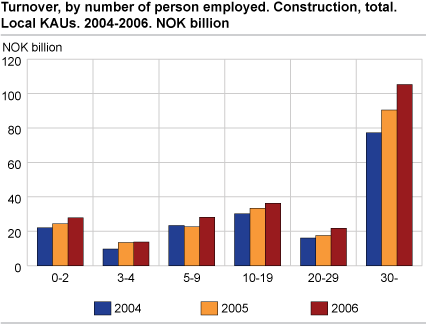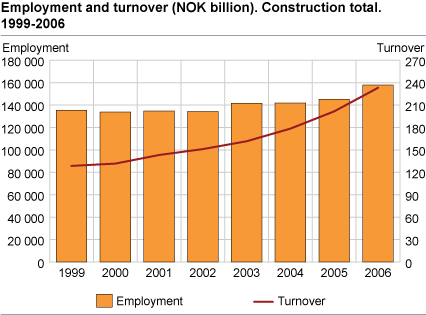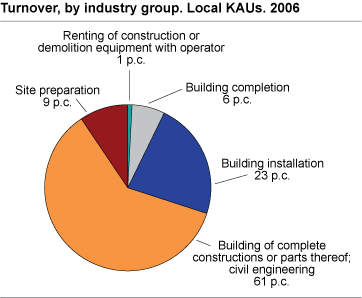Content
Published:
This is an archived release.
Over 40 000 activity units in construction
The number of local kind-of-activity units in the construction industry was 40 200 in 2006, an increase of 4.1 per cent from 2005. The industry is dominated by small establishments, but the few large establishments contribute most to the activity.
In 2006, as many as 84 per cent of the local kind-of activity units (KAUs) in construction had four employees or fewer, but these only contributed to 18 per cent of the turnover. The local KAUs with 30 or more employees only accounted for 2 per cent of the total population, but accounted for more than 45 per cent of the total construction turnover in 2006.
In total, the 40 219 local KAUs in construction had a turnover of NOK 233.1 billion in 2006. This is 15.6 per cent higher than in 2005.
Highest turnover in general construction of buildings
The construction industry is divided into several industry classes. The largest subclass is "General construction of buildings". The local KAUs in this industry class had a total turnover of NOK 95.4 billion and employed 52 021 people in 2006, an increase of 20.3 per cent and 14.6 per cent respectively from 2005. In 2006, this industry class accounted for almost 41 per cent of the total turnover in construction.
Measured by turnover, the second largest class is “Installation of electrical wiring and fittings”. The local KAUs in this industry class had a total turnover of NOK 29.2 billion and employed 26 944 people in 2006, an increase of 13.7 per cent and 9.9 per cent respectively compared to 2005.
Strong increase in employment
The local KAUs in the construction industry employed 157 837 people in 2006, an increase of 8.8 per cent from 2005. Total wage costs amounted to NOK 58.2 billion, up by 14.5 per cent from 2005.
Statistics on enterprise level
The structural business statistics for construction are compiled both on local KAU level and on enterprise level. The figures on enterprise level may differ from figures on local KAU level. This is due to some enterprises being registered in one industry group according to main activity, while at the same time consisting of local KAUs in other groups.
On enterprise level, the turnover increased by 14.5 per cent to NOK 234.3 billion. Total employment was 157 850 persons in 2006.
For more information and definitions, go to About the statistics.
Revision of industriesIn 2007, the enterprises in Statistic Norway’s Central Register of Establishments and Enterprises have been coded in accordance with the new Standard Industrial Classification (SN2007). This has revealed some incorrectly classified enterprises and local KAUs. In such cases, the code according to the current standard (SN2002) has been revised. This implies that on the most detailed level some industrial classes are not fully comparable with previous years. This does not have an effect on the total figures for construction. The structural business statistics will be published in accordance with the new Standard Industrial Classification (SN2007) for the statistical year 2008 in November 2009. |
Tables:
- Table 1 Principal figures, by industry subclass. Local kind-of-activity units. 2005 and 2006
- Table 2 Principal figures, by number of persons employed and industry group. Local kind-of-activity units. 2006
- Table 3 Principal figures for the industrial section, by county. 2006
- Table 4 Principal figures, by region and industry group. Local KAUs. 2006
- Table 5 Principal figures, by industry subclass. Enterprises. 2005 and 2006
- Table 6 Spesification of turnover, by different industry subclass, expressed in percentages. Enterprises. 2006
- Table 7 Principal figures, by number of persons employed and industry group. Entreprises. 2006
- Table 8 Gross Investments, by group of fixed assets and industry subclass. Enterprises. 2006
- Table 9 Gross Investments, by category and industry subclass. Enterprises. 2006
- Table 10 Number of births and deaths of enterprises, by inustry group. 2006
The statistics is now published as Business statistics.
Additional information
Contact
-
Statistics Norway's Information Centre
E-mail: informasjon@ssb.no
tel.: (+47) 21 09 46 42



